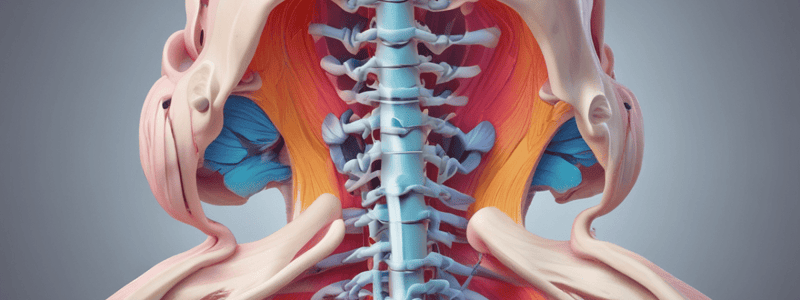Podcast
Questions and Answers
The pressure within the nucleus helps stabilize the peripheral annulus fibrosus.
The pressure within the nucleus helps stabilize the peripheral annulus fibrosus.
True (A)
Lifting a load with the knees straight places less pressure on the lumbar disc compared to lifting with the knees flexed.
Lifting a load with the knees straight places less pressure on the lumbar disc compared to lifting with the knees flexed.
False (B)
Sitting in a forward-slouched position decreases disc pressure compared to sitting erect.
Sitting in a forward-slouched position decreases disc pressure compared to sitting erect.
False (B)
Apophyseal joints in the vertebral column are formed by opposing facet surfaces.
Apophyseal joints in the vertebral column are formed by opposing facet surfaces.
Horizontal facet surfaces within apophyseal joints favor flexion-extension movements.
Horizontal facet surfaces within apophyseal joints favor flexion-extension movements.
Additional factors influencing motion at each spinal region include the attachment of the ribs.
Additional factors influencing motion at each spinal region include the attachment of the ribs.
The resistance of a column with 3 flexible curvatures is R=10.
The resistance of a column with 3 flexible curvatures is R=10.
A spine with normal curvatures has an index below 94%.
A spine with normal curvatures has an index below 94%.
The central portion of the intervertebral disk is called the annulus fibrosus.
The central portion of the intervertebral disk is called the annulus fibrosus.
Collagen type II concentrations are highest in the annulus fibrosus.
Collagen type II concentrations are highest in the annulus fibrosus.
The annulus fibers are not attached to the cartilaginous end plates.
The annulus fibers are not attached to the cartilaginous end plates.
Sharpey’s fibers connect the epiphyseal ring region to the nucleus pulposus.
Sharpey’s fibers connect the epiphyseal ring region to the nucleus pulposus.
Collagen fibers in the intervertebral disk resist all types of forces equally.
Collagen fibers in the intervertebral disk resist all types of forces equally.
Distraction forces are mainly associated with horizontal plane movements.
Distraction forces are mainly associated with horizontal plane movements.
The ratio between disk thickness and height of the vertebral body affects mobility, with a greater ratio leading to less mobility.
The ratio between disk thickness and height of the vertebral body affects mobility, with a greater ratio leading to less mobility.
The closer the nucleus position is to the center, the lower the hydrostatic pressure in the intervertebral disc.
The closer the nucleus position is to the center, the lower the hydrostatic pressure in the intervertebral disc.
Compression force from body weight and muscle contraction lowers the hydrostatic pressure in the nucleus pulposus.
Compression force from body weight and muscle contraction lowers the hydrostatic pressure in the nucleus pulposus.
Increased tension in the annulus facilitates radial expansion of the nucleus in the intervertebral disc.
Increased tension in the annulus facilitates radial expansion of the nucleus in the intervertebral disc.




